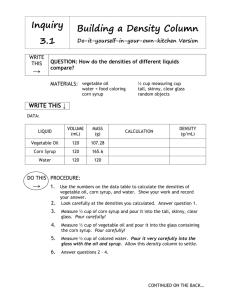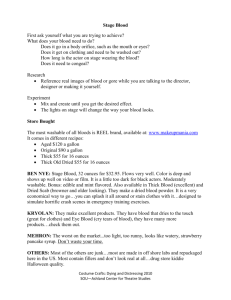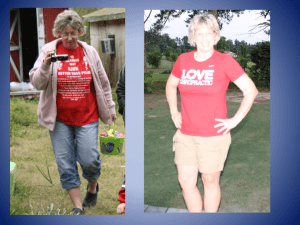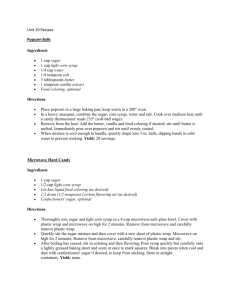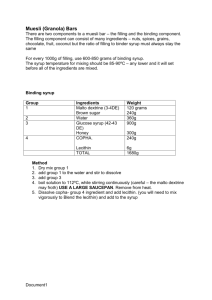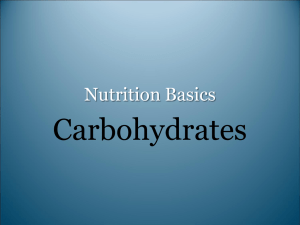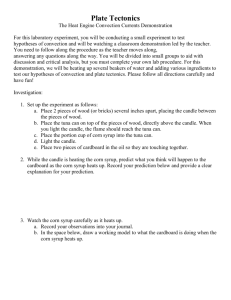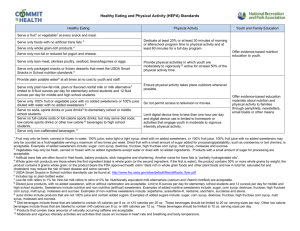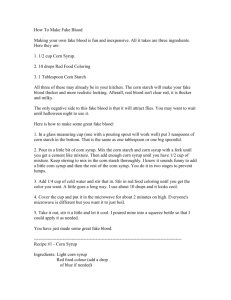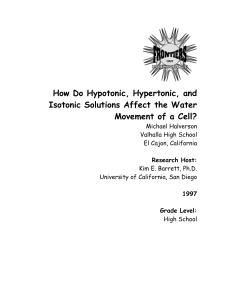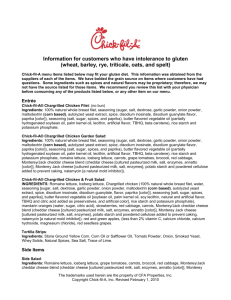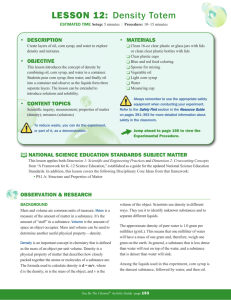Density Layers - Blogs @ Butler
advertisement
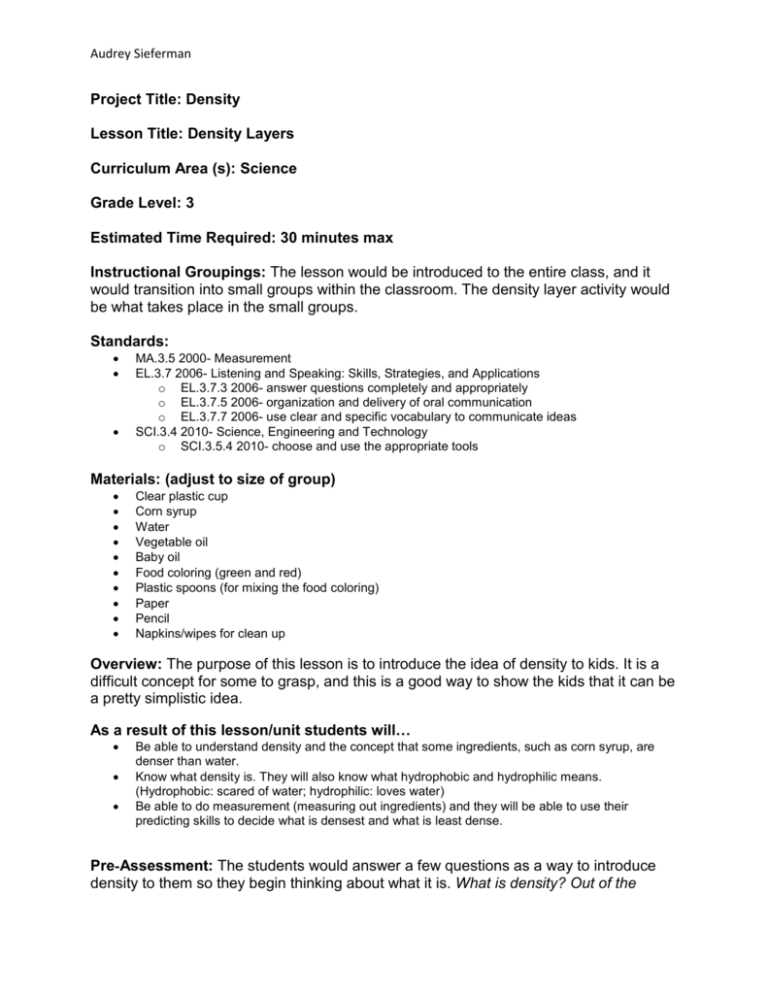
Audrey Sieferman Project Title: Density Lesson Title: Density Layers Curriculum Area (s): Science Grade Level: 3 Estimated Time Required: 30 minutes max Instructional Groupings: The lesson would be introduced to the entire class, and it would transition into small groups within the classroom. The density layer activity would be what takes place in the small groups. Standards: MA.3.5 2000- Measurement EL.3.7 2006- Listening and Speaking: Skills, Strategies, and Applications o EL.3.7.3 2006- answer questions completely and appropriately o EL.3.7.5 2006- organization and delivery of oral communication o EL.3.7.7 2006- use clear and specific vocabulary to communicate ideas SCI.3.4 2010- Science, Engineering and Technology o SCI.3.5.4 2010- choose and use the appropriate tools Materials: (adjust to size of group) Clear plastic cup Corn syrup Water Vegetable oil Baby oil Food coloring (green and red) Plastic spoons (for mixing the food coloring) Paper Pencil Napkins/wipes for clean up Overview: The purpose of this lesson is to introduce the idea of density to kids. It is a difficult concept for some to grasp, and this is a good way to show the kids that it can be a pretty simplistic idea. As a result of this lesson/unit students will… Be able to understand density and the concept that some ingredients, such as corn syrup, are denser than water. Know what density is. They will also know what hydrophobic and hydrophilic means. (Hydrophobic: scared of water; hydrophilic: loves water) Be able to do measurement (measuring out ingredients) and they will be able to use their predicting skills to decide what is densest and what is least dense. Pre‐Assessment: The students would answer a few questions as a way to introduce density to them so they begin thinking about what it is. What is density? Out of the Audrey Sieferman ingredients in front of you, which do you think is the densest? Which do you think is the least dense? (Before each ingredient is poured in make predictions about where the layer will be.) What is the emotional hook? “Have any of you ever helped your parents cook pasta before and seen them use water and oil in the pot? What did you notice about the oil and water? Do you know what this is called? Or why it happened?” o Use connections to their lives to get them intrigued as to why it works the way it does. Explain density, and then do an activity. o Activity: get a few students (2-3) and have them move around freely…explain that they can do so because they aren’t that dense. Then add some more students (2-3) to the group and note how they can’t move around as freely…explain that means that they are denser than before. Keep adding until the students can’t move at all and explain that means they are super dense. Good emotional hook because it gives the chance for the students to “do” the activity and really experience what density is. Steps in the Lesson: Divide the class into equal groups; there should be no more than 4 to 5 students in a group Spread out around the room so that the groups are separated for discussion without disturbing the other groups Start off with predictions o Which liquid do you think is densest? o Which liquid do you think is the least dense? Once everyone has made a prediction (which is part of the pre-assessment) then the activity begins The first liquid to put in is the water; add red food coloring before hand The next liquid to put in is the corn syrup; add the green food coloring to the corn syrup before hand o Before doing so ask the students if they think the corn syrup will be below or above the water o After it is added discuss why it ended up where it did The next liquid to add is the vegetable oil o Ask the same question of where they think the vegetable oil will land amongst the water and corn syrup o After it’s added discuss why it ended up where it did The final liquid added is the baby oil o Ask them where they think it will land o After added discuss why it ended up where it did Closure Activity/Wrap up: Play a small trivia game based off of the density layers; questions would look as follows: o If you have water in your cup and then add corn syrup where will it land? o Which is the densest, baby oil or vegetable oil? o If there is water in the cup and we add baby oil, will the baby oil sink below the water or float above it? Keep track of who gets the most questions correct and the winner gets a prize; but the prize should just be something small (ex. they get to line up first for recess). Post‐Assessment: Exit pass: o They have to write down the definition of density, and state whether vegetable oil is hydrophobic or hydrophilic. It’s a good instant post-assessment to see if they Audrey Sieferman were grasping the concept, and once you move further into the density unit then the post-assessments will continue to include the questions previously asked to make sure they are still remembering the basic information on density. What will I differentiate? I will differentiate the content of the lesson some. There is a lot going on in the lesson when it comes to definitions and terms being used. The concept of density will still be taught, and how the ingredients are where they are because of density, but the talk of hydrophobic and hydrophilic will be left out. Those aren’t as important of terms and are more along the lines of “fun facts” to add. But this is a good lesson to ready students with density, and so that part of the lesson needs to remain the same. The students who will need this differentiation are the students with learning disabilities, but also students who have physical impairments (such as blindness, deafness, or loss of motor use in their hands). Why will I differentiate? For students with blindness; they can partner up with someone in the group and have them describe to them what is happening as each ingredient is added to the cup. They will hopefully be able to sense what is happening, and understand that not all ingredients are the same density, and because of that, things like this happen. For students with deafness; they can observe and write what they are seeing. They just wouldn’t be able to communicate well with what is happening, and be able to vocalize their predictions, but they can record in their notebooks what is going on. They will still be able to fully participate in the activity, but beforehand I would put the written definition of all the terms in the notebook, and type up the procedure and any other information that may be needed that they would then have to read in front of them as the activity progresses. For students with motor loss; these students I would have partner up with someone else in the group. That partner would be the scribe for when observations needed to be written down, and they would do so in their notebook and the other student’s notebook. They would also be the one to pour in the next ingredient, but they would ask the other student which ingredient they want to see poured in next. Having someone who is a peer there to do this I think would allow for more of a sense of freedom because the disabled student doesn’t have to rely on an adult all the time do to things for them. For the students with learning disabilities; I don’t think I would change much for them when it comes to the actual activity. The best way for them to learn is to immerse them in the activity. Once the group part of it is done then I would take the time to meet with them individually and discuss what terms were used, and really dig deep into getting them to understand what was happening during the activity. How will I differentiate? Assistive technology would be an important part of this lesson. The students who can’t hear as well would need to make sure they have a journal and writing utensil so they have an opportunity to communicate their thoughts throughout. Students dealing with blindness need that descriptive language and sound to know what is happening. Students with the motor loss would need ways to be able to do the activity, and they get that through the help of other students. Audrey Sieferman

